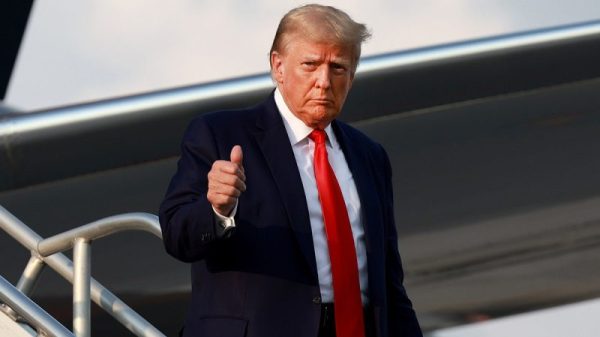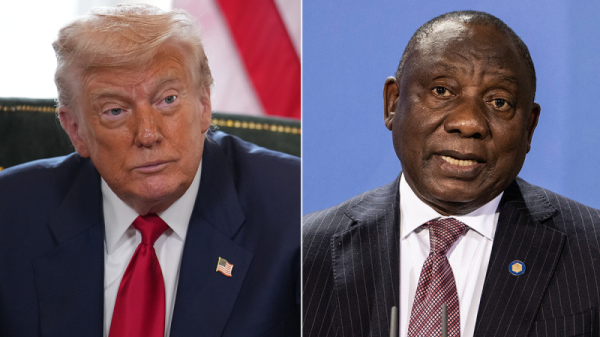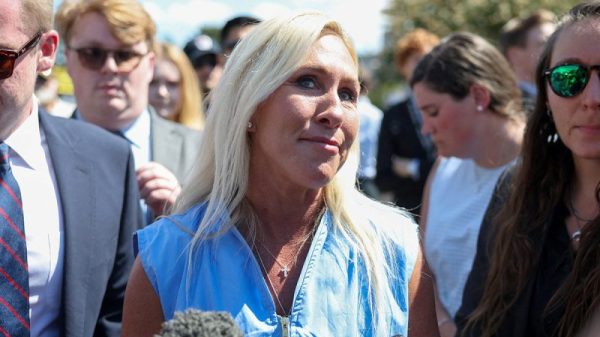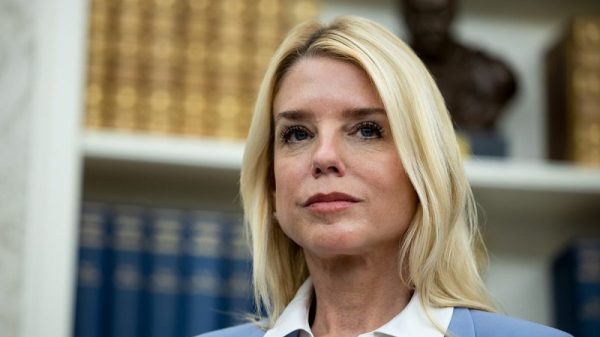California Rep. Kevin McCarthy spent 15 years building the political machine that won back control of the House in 2022 — a sprawling operation with billionaire donor relationships he managed, a recruitment program he oversaw and a network of shadowy political committees that intervened in primaries at the nod of his team.
After only 269 days as House speaker, the fate of that operation is now in question, raising concerns among Republican strategists and members of Congress about their ability to hold or grow their majority next year.
McCarthy tried to calm those worries Friday at the Capitol, telling reporters that he plans to run for reelection and stay involved in elections. He did not state any preference on his successor, calling the two leading contenders for the job — Majority Leader Steve Scalise (R-La.) and House Judiciary Chairman Jim Jordan (R-Ohio) — “good friends.”
“We’ll keep the majority. I’m going to help the people I got here, and we are going to expand it further,” McCarthy said.
Effective control of the biggest electoral institutions that fund Republican House campaigns, like the Congressional Leadership Fund and the National Republican Congressional Committee, is certain to pass to his successor. But the relationships that drive their bank accounts are not certain to follow, nor are the less well-known operations that support both groups in the shadows of campaign finance regulations.
CLF, the centerpiece of House Republican efforts, has grown increasingly dependent on just a few donors in recent years, mostly billionaires who are driven to give more for ideological reasons. The group raised at least $88.5 million last cycle from just eight families and millions more from McCarthy’s own California donors. After McCarthy was toppled, the NRCC announced it was postponing a fall gala event next week in Dallas.
“The happiest people in Washington this week are the people at the DCCC and House Majority PAC who just saw the number one fundraiser in the Republican field taken off the field,” said Mike Shields, a McCarthy ally and campaign strategist who previously ran CLF and worked as political director of the NRCC, referring to two pro-Democratic committees.
McCarthy’s aspiring replacements have boasted about their different fundraising strengths as they have sought votes from their colleagues. Allies of Jordan, a firebrand known for rapid-fire cable news appearances, have even been circulating private emails that Scalise’s staff have sent to Jordan’s team in recent months, asking Jordan to sign off on emails and text messages in his name that would jointly raise money for the two men.
“No one is better positioned to help [boost] the confidence in fundraising than Jim Jordan,” said Russell Dye, a spokesman for Jordan. “He’s the only person who can communicate with both the grass-roots and the megadonors.”
Scalise has pushed back with a memo from his team calling him a “fundraising powerhouse” with $170 million in lifetime fundraising, including 413 days of travel time.
“While Kevin’s fundraising was unmatched, Steve Scalise was easily the second most prolific fundraiser for the conference,” said Rep. Tony Gonzales (R-Tex.), who is backing Scalise for speaker.
But no one has argued that the transition will be painless. Donors and some Republican operatives have expressed concerns over whether the next speaker will remain as aggressive as McCarthy is in promoting candidates who can win swing seats or as ruthless as he has been in intervening to try to stop less-electable or more disruptive candidates in Republican districts from making it to the House floor.
Groups connected to McCarthy spent millions to defend incumbents against far-right challengers in primaries, sometimes using spending vehicles that were designed to conceal the identity of donors. They also weeded out Republican candidates that they thought did not belong in Washington, even if they could have won office.
McCarthy allies were involved in 2022 in raising money for a group called Results for N.C. that helped to defeat one of McCarthy’s own members, Rep. Madison Cawthorn (R-N.C.), after the freshman lawmaker infuriated his colleagues by talking on a podcast about seeing cocaine use in Washington and being invited to sex parties.
Other groups, with names like American Liberty Action and the Eighteen Fifty-Four Fund, were deployed to take out the primary campaigns of Anthony Sabatini, a Florida friend of Rep. Matt Gaetz, and former New York state party chair Carl Paladino, who suggested in a 2021 social media post that Nazi dictator Adolf Hitler is “the kind of leader we need today.”
CLF, under the guidance of McCarthy’s team, intervened in a Florida primary to help defeat Laura Loomer, a political activist who has described herself as being “pro-white nationalism” and a “proud Islamophobe.” CLF also spent heavily, through vehicles that were difficult to track, in a failed effort to defend Rep. Jamie Herrera-Beutler (R-Wash.), a supporter of former president Donald Trump’s second impeachment. After she lost, Democrats were able to pick up the seat on the southern Washington state border.
Dan Conston, a McCarthy adviser who runs CLF, said in a statement after McCarthy’s ouster that the group “remains laser-focused on our mission of holding radical Democrats accountable, protecting our vulnerable incumbents, and expanding the House Republican majority.”
But no one knows whether the next speaker will have the power or will of McCarthy to be as aggressive in primaries. His hard-line opponents in the House have long demanded that these interventions stop. Before McCarthy was elected speaker in January, Conston agreed to a small concession — that CLF would not involve itself anymore in open-primary contests in safe Republican seats. That agreement did not rule out intervention by other groups that worked with McCarthy’s team.
At a news conference after losing the speakership, McCarthy suggested he could become even more involved in shaping primary campaigns, even if it meant that he was working independently of leadership. Both McCarthy and his allies have made clear their anger at the eight Republicans who voted to end his speakership.
“I told the conference I am a free agent now, aren’t I?” McCarthy said, in a thinly veiled warning of possible retribution. “I think I am pretty good at electing people.”
Whatever he does, the playbook for the 2024 House elections must now be worked out on the fly, in the middle of an election season. Democrats have been crowing, in public and private, in recent days about the confusion that McCarthy’s absence could create, including the possibility of more retirements and recruitment challenges.
“McCarthy famously tried to be all things to all people, and while that was his undoing as speaker, being a bridge between MAGA world and ultrawealthy donors made him a good fundraiser,” said Tim Persico, former executive director of the Democratic Congressional Campaign Committee. “I doubt any of the heir apparents have those relationships, and trying to replicate decades of work in a few months is damn near impossible.”
Neither Scalise nor Jordan comes close to McCarthy in the depth of donor relationships or electoral experience, according to Republican strategists. With a donor network he built in the California state assembly, McCarthy created the Young Guns program during the 2008 cycle, traveling the country to promote a new generation of House candidates. In the 2010 cycle, that program became the name of the NRCC’s recruitment program, which McCarthy ran during a cycle that returned a Republican to the speaker’s office. He has remained integrally involved in the effort ever since.
For more than a decade, McCarthy traveled the country at nearly every congressional break, meeting with prospective candidates and golfing with billionaires. His annual August donor retreat in Jackson Hole, Wyo. — inherited from a similar event hosted by former Speaker John A. Boehner (R-Ohio) — became a marquee forum for young politicians to meet the donors who would fund their campaigns.
McCarthy also created a joint fundraising program — first called Take Back the House and now called Protect the House — that allows wealthy donors to give hundreds of thousands of dollars at once, with the money split up to support the candidates most at risk of defeat. Ironically, that has meant that McCarthy’s program has already transferred more than $100,000 this year to the campaigns of Rep. Nancy Mace (R-S.C.), who voted to end his speakership, and Rep. Lauren Boebert (R-Colo.), who opposed his efforts to pass a spending bill last month.
McCarthy’s behind-the-scenes power reflects changes in campaign finance laws since the early 2000s that have empowered very wealthy donors and the politicians they trust with their money. Rep. Nancy Pelosi (D-Calif.) was able to twice hold the titles of minority leader and speaker because of the dependence of her caucus on her donor network. When she stepped aside last year, one of her top political advisers, Michael Smith, took over at the head of the pro-Democratic House Majority PAC, insuring continuity as Rep. Hakeem Jeffries (D-N.Y.) took charge of the conference.
“A new speaker, depending on who it is, can rise to the occasion,” said one Republican strategist familiar with the succession discussion happening now, who spoke on the condition of anonymity to discuss private conversations. “Their greatest challenge is the absence of time. You don’t build something like this in months. It took years.”
Sarah Chamberlain, the president of the Republican Main Street Partnership, described McCarthy as “the best fundraiser the Republican Party has had in years.”
“He’s in a league by himself for right now,” she said. “We’re absolutely hoping that he continues to do that.”
Leigh Ann Caldwell and Marianna Sotomayor contributed to this report.
California Rep. Kevin McCarthy spent 15 years building the political machine that won back control of the House in 2022 — a sprawling operation with billionaire donor relationships he managed, a recruitment program he oversaw and a network of shadowy political committees that intervened in primaries at the nod of his team.
After only 269 days as House speaker, the fate of that operation is now in question, raising concerns among Republican strategists and members of Congress about their ability to hold or grow their majority next year.
McCarthy tried to calm those worries Friday at the Capitol, telling reporters that he plans to run for reelection and stay involved in elections. He did not state any preference on his successor, calling the two leading contenders for the job — Majority Leader Steve Scalise (R-La.) and House Judiciary Chairman Jim Jordan (R-Ohio) — “good friends.”
“We’ll keep the majority. I’m going to help the people I got here, and we are going to expand it further,” McCarthy said.
Effective control of the biggest electoral institutions that fund Republican House campaigns, like the Congressional Leadership Fund and the National Republican Congressional Committee, is certain to pass to his successor. But the relationships that drive their bank accounts are not certain to follow, nor are the less well-known operations that support both groups in the shadows of campaign finance regulations.
CLF, the centerpiece of House Republican efforts, has grown increasingly dependent on just a few donors in recent years, mostly billionaires who are driven to give more for ideological reasons. The group raised at least $88.5 million last cycle from just eight families and millions more from McCarthy’s own California donors. After McCarthy was toppled, the NRCC announced it was postponing a fall gala event next week in Dallas.
“The happiest people in Washington this week are the people at the DCCC and House Majority PAC who just saw the number one fundraiser in the Republican field taken off the field,” said Mike Shields, a McCarthy ally and campaign strategist who previously ran CLF and worked as political director of the NRCC, referring to two pro-Democratic committees.
McCarthy’s aspiring replacements have boasted about their different fundraising strengths as they have sought votes from their colleagues. Allies of Jordan, a firebrand known for rapid-fire cable news appearances, have even been circulating private emails that Scalise’s staff have sent to Jordan’s team in recent months, asking Jordan to sign off on emails and text messages in his name that would jointly raise money for the two men.
“No one is better positioned to help [boost] the confidence in fundraising than Jim Jordan,” said Russell Dye, a spokesman for Jordan. “He’s the only person who can communicate with both the grass-roots and the megadonors.”
Scalise has pushed back with a memo from his team calling him a “fundraising powerhouse” with $170 million in lifetime fundraising, including 413 days of travel time.
“While Kevin’s fundraising was unmatched, Steve Scalise was easily the second most prolific fundraiser for the conference,” said Rep. Tony Gonzales (R-Tex.), who is backing Scalise for speaker.
But no one has argued that the transition will be painless. Donors and some Republican operatives have expressed concerns over whether the next speaker will remain as aggressive as McCarthy is in promoting candidates who can win swing seats or as ruthless as he has been in intervening to try to stop less-electable or more disruptive candidates in Republican districts from making it to the House floor.
Groups connected to McCarthy spent millions to defend incumbents against far-right challengers in primaries, sometimes using spending vehicles that were designed to conceal the identity of donors. They also weeded out Republican candidates that they thought did not belong in Washington, even if they could have won office.
McCarthy allies were involved in 2022 in raising money for a group called Results for N.C. that helped to defeat one of McCarthy’s own members, Rep. Madison Cawthorn (R-N.C.), after the freshman lawmaker infuriated his colleagues by talking on a podcast about seeing cocaine use in Washington and being invited to sex parties.
Other groups, with names like American Liberty Action and the Eighteen Fifty-Four Fund, were deployed to take out the primary campaigns of Anthony Sabatini, a Florida friend of Rep. Matt Gaetz, and former New York state party chair Carl Paladino, who suggested in a 2021 social media post that Nazi dictator Adolf Hitler is “the kind of leader we need today.”
CLF, under the guidance of McCarthy’s team, intervened in a Florida primary to help defeat Laura Loomer, a political activist who has described herself as being “pro-white nationalism” and a “proud Islamophobe.” CLF also spent heavily, through vehicles that were difficult to track, in a failed effort to defend Rep. Jamie Herrera-Beutler (R-Wash.), a supporter of former president Donald Trump’s second impeachment. After she lost, Democrats were able to pick up the seat on the southern Washington state border.
Dan Conston, a McCarthy adviser who runs CLF, said in a statement after McCarthy’s ouster that the group “remains laser-focused on our mission of holding radical Democrats accountable, protecting our vulnerable incumbents, and expanding the House Republican majority.”
But no one knows whether the next speaker will have the power or will of McCarthy to be as aggressive in primaries. His hard-line opponents in the House have long demanded that these interventions stop. Before McCarthy was elected speaker in January, Conston agreed to a small concession — that CLF would not involve itself anymore in open-primary contests in safe Republican seats. That agreement did not rule out intervention by other groups that worked with McCarthy’s team.
At a news conference after losing the speakership, McCarthy suggested he could become even more involved in shaping primary campaigns, even if it meant that he was working independently of leadership. Both McCarthy and his allies have made clear their anger at the eight Republicans who voted to end his speakership.
“I told the conference I am a free agent now, aren’t I?” McCarthy said, in a thinly veiled warning of possible retribution. “I think I am pretty good at electing people.”
Whatever he does, the playbook for the 2024 House elections must now be worked out on the fly, in the middle of an election season. Democrats have been crowing, in public and private, in recent days about the confusion that McCarthy’s absence could create, including the possibility of more retirements and recruitment challenges.
“McCarthy famously tried to be all things to all people, and while that was his undoing as speaker, being a bridge between MAGA world and ultrawealthy donors made him a good fundraiser,” said Tim Persico, former executive director of the Democratic Congressional Campaign Committee. “I doubt any of the heir apparents have those relationships, and trying to replicate decades of work in a few months is damn near impossible.”
Neither Scalise nor Jordan comes close to McCarthy in the depth of donor relationships or electoral experience, according to Republican strategists. With a donor network he built in the California state assembly, McCarthy created the Young Guns program during the 2008 cycle, traveling the country to promote a new generation of House candidates. In the 2010 cycle, that program became the name of the NRCC’s recruitment program, which McCarthy ran during a cycle that returned a Republican to the speaker’s office. He has remained integrally involved in the effort ever since.
For more than a decade, McCarthy traveled the country at nearly every congressional break, meeting with prospective candidates and golfing with billionaires. His annual August donor retreat in Jackson Hole, Wyo. — inherited from a similar event hosted by former Speaker John A. Boehner (R-Ohio) — became a marquee forum for young politicians to meet the donors who would fund their campaigns.
McCarthy also created a joint fundraising program — first called Take Back the House and now called Protect the House — that allows wealthy donors to give hundreds of thousands of dollars at once, with the money split up to support the candidates most at risk of defeat. Ironically, that has meant that McCarthy’s program has already transferred more than $100,000 this year to the campaigns of Rep. Nancy Mace (R-S.C.), who voted to end his speakership, and Rep. Lauren Boebert (R-Colo.), who opposed his efforts to pass a spending bill last month.
McCarthy’s behind-the-scenes power reflects changes in campaign finance laws since the early 2000s that have empowered very wealthy donors and the politicians they trust with their money. Rep. Nancy Pelosi (D-Calif.) was able to twice hold the titles of minority leader and speaker because of the dependence of her caucus on her donor network. When she stepped aside last year, one of her top political advisers, Michael Smith, took over at the head of the pro-Democratic House Majority PAC, insuring continuity as Rep. Hakeem Jeffries (D-N.Y.) took charge of the conference.
“A new speaker, depending on who it is, can rise to the occasion,” said one Republican strategist familiar with the succession discussion happening now, who spoke on the condition of anonymity to discuss private conversations. “Their greatest challenge is the absence of time. You don’t build something like this in months. It took years.”
Sarah Chamberlain, the president of the Republican Main Street Partnership, described McCarthy as “the best fundraiser the Republican Party has had in years.”
“He’s in a league by himself for right now,” she said. “We’re absolutely hoping that he continues to do that.”
Leigh Ann Caldwell and Marianna Sotomayor contributed to this report.





















